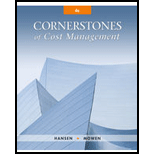
Shorts Manufacturing, Inc., has implemented lean manufacturing in its Kansas City plant as a pilot program. One of its value streams produces a family of small electric tools. The value-stream team managers were quite excited about the results, as some of their efforts to eliminate waste were proving to be effective. During the most recent three weeks, the following data pertaining to the electric tool value stream were collected:
Week 1:
Demand = 90 units @ $40
Beginning inventory = 10 units @ $20 ($5 materials and $15 conversion)
Production = 90 units using $450 of material and $1,350 of conversion cost
Week 2:
Demand = 100 units @ $40
Beginning inventory = 10 units @ $20 ($5 materials and $15 conversion)
Production = 90 units using $450 of material and $1,350 of conversion cost
Week 3:
Demand = 90 units @ $40
Beginning inventory = 0
Production = 100 units using $500 of material and $1,500 of conversion cost
Required:
- 1. Prepare a traditional income statement for each week.
- 2. Calculate the average value-stream product cost for each week. What does this cost signal, if anything?
- 3. Prepare a value-stream income statement for each week. Assume that any increase in inventory is valued at average cost. Comment on the financial performance of the value stream and its relationship to traditional income measurement.
Want to see the full answer?
Check out a sample textbook solution
Chapter 15 Solutions
Bundle: Cornerstones of Cost Management, Loose-Leaf Version, 4th + CengageNOWv2, 1 term Printed Access Card
- I want answer with all working formatarrow_forwardThe total manufacturing cost for Octoberarrow_forwardDuring April, the production department of a process operations system completed and transferred to finished goods a total of 65,000 units of product. At the end of March, 15,000 additional units were in process in the production department and were 80% complete with respect to materials. The beginning inventory included a materials cost of $57,500 and the production department incurred a direct materials cost of $183,000 during April. Compute the direct materials cost per equivalent unit for the department using the weighted-average method. Questionarrow_forward
 Cornerstones of Cost Management (Cornerstones Ser...AccountingISBN:9781305970663Author:Don R. Hansen, Maryanne M. MowenPublisher:Cengage Learning
Cornerstones of Cost Management (Cornerstones Ser...AccountingISBN:9781305970663Author:Don R. Hansen, Maryanne M. MowenPublisher:Cengage Learning Managerial AccountingAccountingISBN:9781337912020Author:Carl Warren, Ph.d. Cma William B. TaylerPublisher:South-Western College Pub
Managerial AccountingAccountingISBN:9781337912020Author:Carl Warren, Ph.d. Cma William B. TaylerPublisher:South-Western College Pub Managerial Accounting: The Cornerstone of Busines...AccountingISBN:9781337115773Author:Maryanne M. Mowen, Don R. Hansen, Dan L. HeitgerPublisher:Cengage Learning
Managerial Accounting: The Cornerstone of Busines...AccountingISBN:9781337115773Author:Maryanne M. Mowen, Don R. Hansen, Dan L. HeitgerPublisher:Cengage Learning Excel Applications for Accounting PrinciplesAccountingISBN:9781111581565Author:Gaylord N. SmithPublisher:Cengage Learning
Excel Applications for Accounting PrinciplesAccountingISBN:9781111581565Author:Gaylord N. SmithPublisher:Cengage Learning Financial And Managerial AccountingAccountingISBN:9781337902663Author:WARREN, Carl S.Publisher:Cengage Learning,
Financial And Managerial AccountingAccountingISBN:9781337902663Author:WARREN, Carl S.Publisher:Cengage Learning, Essentials of Business Analytics (MindTap Course ...StatisticsISBN:9781305627734Author:Jeffrey D. Camm, James J. Cochran, Michael J. Fry, Jeffrey W. Ohlmann, David R. AndersonPublisher:Cengage Learning
Essentials of Business Analytics (MindTap Course ...StatisticsISBN:9781305627734Author:Jeffrey D. Camm, James J. Cochran, Michael J. Fry, Jeffrey W. Ohlmann, David R. AndersonPublisher:Cengage Learning





